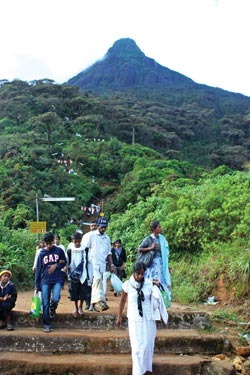Pioneer insights to Sri Pada – Part 1
 Quite a lot has been written on the sacred mount of Sri Lanka known
as Sri Pada or Samantakuta, to local pilgrims and Adam’s Peak to
foreigners. One of the pioneer series of jottings comes from the notes
made by Archibald Campbell Lawrie in 1896. Quite a lot has been written on the sacred mount of Sri Lanka known
as Sri Pada or Samantakuta, to local pilgrims and Adam’s Peak to
foreigners. One of the pioneer series of jottings comes from the notes
made by Archibald Campbell Lawrie in 1896.
In his compilation of place names known as ‘A Gazetteer of the
Central Province of Ceylon, initially printed by the Government Printer
and later reprinted by the State Printing Corporation of Sri Lanka.
For those who are interested in knowing some of the basic facts
relating to the Sacred Mount, I wish to quote Lawrie especially to
highlighted how the facts are presented.
He commences his investigation as follows:
Adam’s Peak - The most conspicuous mountain in Ceylon, 7,352.8 ft
high. It is situated in 6.. 48’ 49” N and 80.. 29’ 58” E., on the
boundary of the Central Province and Sabaragamuwa, 10 miles North-East
of Ratnapura.
Knox (1659-1679) says:-
On the south side of Conde Uda is a hill, supposed to be the highest
in this Island, called in the Chingulay language Hamatell, but by the
Portuguese and the European nations Adam’s Peak. It is in shape like a
sugar loaf, and on the top a flat stone with the print of a foot like a
man’s on it, but far bigger, being about two feet long.
|

Sri Pada: the most conspicuous mountain in Ceylon |
The people of this land count it meritorious to go and worship this
impression and generally about their new year, which is in March, they -
men, women and children - go up this vast and high mountain to
worship............ Out of this mountain arise many fine rivers, which
run through the land, some to the westward, some to the southward, and
the main river, Maveliganga, to the northward. (Knox, Hist. Rel., p.5).
He (Buddoo) departed from this earth from the top of the highest
mountain on the Island, called Pico Adam, where there is an impression
like a foot, which they say is his. (Ib., p. 144).
(Buddha’s) great festival is in the month of March at their new
year’s tide. The places where he is commemorated are two - not temples,
but the one a mountain, and the other a tree ...... the mountain where
is the print of the Buddoo’s foot, which he left on the top of that
mountain in a rock, from whence he ascended to heaven: unto this
footstep they give worship, light up lamps, and offer sacrifices, laying
them upon it as upon an altar.
The benefit of the sacrifices that are offered here do belong unto
the Moor’s pilgrims, who come over from the other coast to beg, this
having been given them heretofore by a former king: so that at this
season there are great numbers of them always waiting there to receive
their accustomed fees. (lb., p. 161).
Then he quotes an authority Dr. Davy as follows:
Dr. Davy writing in 1818 says (p. 343):-
The summit is small. According to the measurement made by Lieut.
Malcolm (the first European who ascended the Peak), its area is 74 x 24
ft. It is surrounded by a stone wall 5 ft. high, built in some places on
the brink of the precipice.
The apex of the mountain is a rock, which stands in the middle of the
enclosure about 6 or 8 ft. above the level ground. On its top is the
object of worship of the natives - the Sree Pada, the sacred impression,
as they imagine, of the foot of Boodho, which he stamped on his first
visit to the Island.
It is a superficial hollow, 5 ft. 4 3/4 in. long, and between 2 ft. 7
in. and 2 ft. 5 in. wide. It is ornamented with a margin of brass
studded with a few gems of little value; it is covered with a roof,
which is fastened to the rock by four iron chains and supported by four
pillars, and it is surrounded by a low wall. The roof was lined with
coloured cloths.
Lawrie makes use of a source titled as Rambles of Ceylon written by
Lieutenant De Butts to unearth further details as follows:
“The summit of Adam’s Peak embraces a flat oblong area of 200 square
yards. Of this space, a large portion is occupied by a mass of rock,
upon which a gigantic impression of the human footstep is stamped.
The impression is slightly, but indelibly, indented on the smooth
surface of the rock, and measures nearly 5 1/2 ft. in length by 30 in.
in average breadth.
Believers and sceptics are indifferently permitted to ascend this
rock and examine the footprint; but the entree into a small temple,
which is erected upon and adorns this sacred spot, is reserved for the
devout disciples of Boodhoo.” (Rambles in Ceylon by Lieut. De Butts,
1841, pp. 238, 239.)
[email protected]
To be continued next week |



